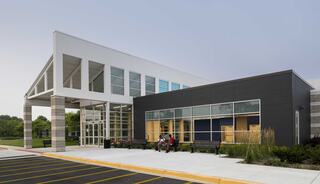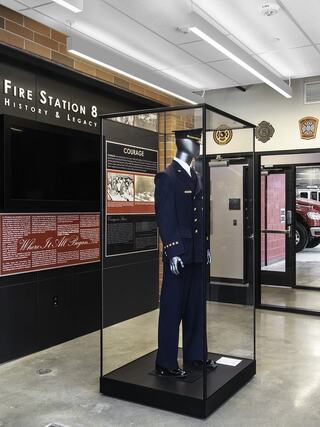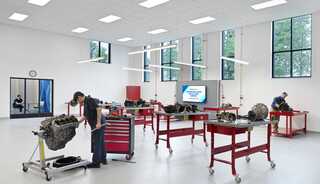
10 Tips for Renovating or Designing a Church Youth Room

One of the biggest questions in all youth ministry: How do I design an appealing space for teens?
There are many large churches that pay good money for their youth ministries to have brand new, state-of-the-art, top-notch youth spaces. For other churches that do not need to build a new space, or for churches that simply can't afford it, this is usually a DIY project – making the best of what already exists.
If you belong to a church that is considering such a project, we would love to help you. The biggest piece of advice we can offer in preparation for that effort is to COLLABORATE. If you are struggling to get buy-in for a dedicated youth space, partner with other ministry leaders who can benefit from the space when you aren't using it.
In general, teens want to be in the same types of environments that many adults do.
Often, the people most in need of design direction are the ones with the fewest resources, and they seldom get much say in suiting a physical environment to the ministry that happens within. Some youth ministers have a great eye for design or have someone at their disposal to help. For the rest, the youth room (if a church is blessed to have one!) often receives little design attention and quickly accumulates ratty furniture, dated posters and all the other stuff that nobody else wanted. We expect our teens to actually want to connect and relax in this space. Imagine if any business set themselves up this way!
The Gospel itself is an inspiring message and must be the core of every ministry effort; without its content, the environment matters little. Effective ministry can be done in any setting, but that does not mean the physical environment is insignificant. In a world dominated by distractions vying for what little bandwidth teens have between school, activities and the onslaught of information in our digital age, teens often have their guards up against being vulnerable and receiving new information as genuine. A welcoming, safe and enjoyable environment can influence how people interact with their experiences there. Teens will be more inclined to engage in fellowship and messages offered if they are comfortable in their physical environment.
Teenagers generally prefer to be in the same types of environments that many adults do: well-designed, trendy and active settings, like restaurants, coffee shops, music venues and other bustling locations. Doing something novel isn’t required. When visiting places, look around and consider what makes them enjoyable environments. Perhaps it’s the access to natural light or plants, a cozy furniture setting, the textures of the materials or even how easy it was to hear friends. A handful of elements create a really successful place to gather, pray, study, recreate, etc.
Explore the following ideas and practical DIY tips for renovating (or planning new) youth rooms. These layers of design concepts will help in building an impactful youth ministry environment.
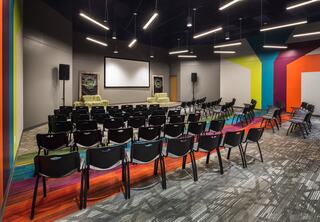
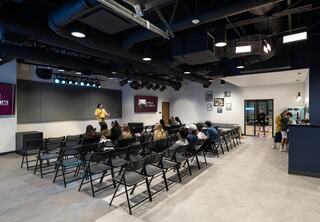
1. CLEAR THE CLUTTER
Cost: $0 | Effort: medium to high
A youth room should not look like a storage closet. Decide what really needs to be out on a regular basis and store the rest. If there is not an available closet, consider purchasing or building shelving or cabinets. Unused items that have accumulated over time do more harm than good by cluttering the room; consider donating excess items. Assign someone to own the stewardship of the space. Each week, organize the room to its original state, carefully returning items to their appropriate home. Being a good steward and keeping only what is needed and used is a valuable lesson for the young people to whom you minister.
>>> Know the exact purpose that everything in the room serves and make sure it's essential!
2. PLAN THE SPACE
Cost: $0 | Effort: low to medium
Understand what activities you need to accommodate in the room. Is the space intended primarily for assemblies, un-programmed lounging and hangout time, or for small group meetings? All of the above? Know the amount of space you need and understand how those spaces need to work together. Think of a room in terms of zones of space. The materials and furnishings need to serve the function of the zone to visually cue what is happening in each area. Draw a scale drawing of your room on grid paper or inexpensive drafting software and put in all of the items you already have and the ones you hope to buy. You can use tape to mark off spaces in the room to get a feel for scale as you determine how you want to configure your layout.
>>> Draw room plans in advance and make sure they work well for expected activities.
3. USE COLOR WISELY
Cost: $ | Effort: low to medium
Paint is one of the most cost effective and quick ways to change the feel of an environment. Refined color palettes are a central feature in modern spaces. Look at magazines, stores, restaurants and other trendy places for examples of colors that feel fresh, classic, bold, energizing or calming. When picking paint or finishes, take a few photos or save images to an inspiration board. When in doubt, ask for input from a trusted friend whose taste and style you admire. Include teens and young adults in the process; they may have valuable ideas based on their favorite places to frequent. In addition to paint, there may also be opportunities to incorporate design elements like stripes, accent trim, metal, wood slats, wallpaper or beadboard wainscoting to enhance your wall’s personality and even protect them from in busy, high-traffic areas.
>>> Pick modern, dynamic colors and accents, decide where to use it, and transform the room from boring to refreshed.
4. LIGHTING MATTERS!
Cost: $$ | Effort: low
In addition to color, lighting is an extremely powerful way to change a room. Unfortunately, the majority of youth rooms are adapted from classrooms with the classic 2x4 white acoustic ceiling tile grids and fluorescent lighting—which doesn’t exactly promote a fun, inviting or intimate setting. Fortunately, inexpensive floor lamps are a way to quickly improve the setting. Try plugging them into switch outlets or use an extension cord with an on/off button.
Go the extra mile by having the fluorescent lights in the ceiling replaced or add recessed can lights, which can be fit with incandescent or warmer colored LED bulbs (color temperature = 2700 K) to produce a much warmer, living-room-like setting. If the ceiling tiles are bothersome, consider painting them. Keep in mind that this will negatively affect the acoustical properties (they won't absorb sound as well). Another approach is to cover them in dark fabric. Combined with recessed canned lights, a darker ceiling will quickly transform a room into an intimate setting, similar to a cozy coffee shop or restaurant.
Lastly, decide on window treatments. Controlling the light in a room may be crucial for certain times of day or the year. Inexpensive 2" faux wood blinds or fabric roller shades are simple solutions that cut down glare and add some informal comfort to a room. An inexpensive curtain rod and curtains can also soften the room and offer the ability to completely black out the room if needed.
>>> Create a dramatic change in atmosphere with simple lighting changes!
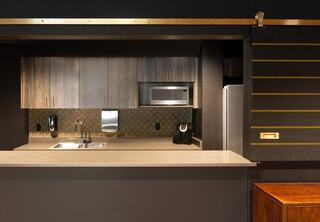
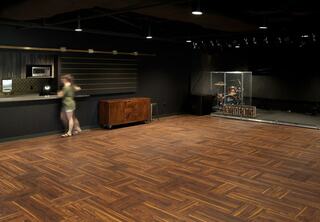
5. FLOORING ISN'T BORING
Cost: $$ - $$$ | Effort: low
Great flooring can make or break a room. If flooring cannot be changed, consider using rugs to transform the aesthetic. If there is an opportunity to replace old carpet or vinyl composition tile (VCT, which is used in most classrooms nationwide), consider wood-look vinyl planks or carpet tiles, two products that are affordable, look sharp, are extremely durable and easy to install. In general, resilient (hard) flooring like concrete, vinyl or tile is good for heavy traffic areas and anywhere food is served. Carpet helps create a softer feel in areas that need more intimacy. Carpet tiles are also a good option for larger rooms that need a quieter setting for assemblies, and by keeping some extra stock of carpet tiles, replacing damaged areas is a breeze. Visit a local flooring store to narrow down some options. Again, take note of flooring examples that exist in restaurants, coffee shops, bars and even in newer public buildings like libraries and airports. If you see something you like, take a picture.
>>> If there is an opportunity to replace a floor at the end of its lifespan, do some scouting homework on the best products for what might work best in the youth space!
6. PULL UP A (COMFORTABLE) CHAIR
Cost: $$ - $$$ | Effort: low
Old furniture communicates a lack of concern or care about the level of comfort that visitors will have in the room. Furniture will be one of the more costly additions to the room, but it is worth the cost. Many furniture stores offer great deals on basic leather, synthetic leather and microfiber furniture that is durable and fashionable. Make sure to check the care instructions on the provided fabric to ensure cleaning is manageable for staff, volunteers or the teens themselves. If food will be served in this space, choose a fabric that can easily be wiped clean. Search for deals from manufacturers on chairs for assembly seating to replace dated metal folding chairs (that are most likely covered in half-peeled stickers!). Consider comfortable mesh chairs that either fold or stack; they’re not much more expensive than the common-but-uncomfortable metal folding chairs or stacking plastic chairs. In addition to supporting teens’ focus by improving comfort, an investment in seating really shows a commitment to providing a welcoming atmosphere. Refer to tip number 10 for ideas on acquiring furniture.
>>> Invest in durable, comfortable seating that creates an inviting setting.
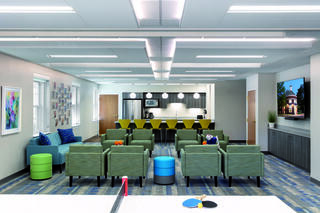
Youth Room at Lewinsville Presbyterian Church
7. DÉCOR & MORE
Cost: $ - $$ | Effort: medium
Don't try too hard to preach with your décor (ditch the cliché inspirational posters filled with Bible verses). Beautiful, authentic artwork can have a much greater impact on the interior of a youth room than cheesy or dated posters. Keep it local by commissioning a church member to create something fitting. Or consider using a logo or graphic as a centerpiece on a feature wall. This could be stencil-painted directly on the wall or made from another material. Sign makers and laser or water jet companies offer some relatively affordable options in vinyl, metal, plastic and even wood. Hiring a qualified graphic designer, whether they work for themselves or a sign company, can help ensure that visual elements are created with a clear purpose. A clean, well-painted wall often looks more sophisticated than one that is cluttered. When in doubt, aim for simplicity and intentionality.
>>> Don't hang it on a wall unless it's necessary and beautiful!
8. BE SMART ABOUT TECHNOLOGY
Cost: $$ - $$$ | Effort: low
Technology can make a room feel alive, but it’s important to think about its purpose in the design of a church youth room. Tech is cheaper than ever, but that doesn’t always mean more is better. Too much technology and screens may overwhelm the space and weaken the message. Technology in youth ministry spaces should support the incorporated activities, like worship, teaching or announcements, instead of taking over the room. A high-tech setup is not necessary for every ministry; many can function well with very little Audio/Visual (A/V) integration. A moderate amount of technology used thoughtfully for digital signage, videos or song lyrics can improve communication and create a lively, distraction-free environment. The goal is to be intentional: incorporate technology that supports the mission without getting in the way.
>>> Plan the areas where technology can pack the most punch to liven up space to help save time and effort!

Students Entry at The Austin Stone West church campus
9. BRAND IT
Cost: $ - $$ | Effort: high
In church youth room design, using purposeful graphic design helps people feel a sense of belonging and creates a cohesive environment. From an architectural perspective, consistent branding — such as ministry logos, names and visual themes — can make a space feel planned and welcoming to teens. A helpful volunteer, a church member with graphic design experience or even a student- or youth group member-centric design challenge can kick-start the process of developing a unified visual theme. Incorporating similar graphics into event flyers, announcements, digital signage and other church materials communicates connection and organization.
>>> Be mindful about what is produced; make sure it is of a high quality that complements the ministry’s vision.
10. MAKE IT HAPPEN!
In church design, the only unhelpful question is the one left unspoken. Many times, ministries are not equipped with the desired resources simply because they didn’t ask. Start with a conversation with your pastor to see what the church can provide or budget for in the future. Involve some parents in design ideas and planning in case they might want to chip in. One creative group fundraiser idea is aTrash or Treasure Sale: announce several weeks in advance that the youth ministry will be accepting goods and donations for a public church garage sale. Accept the items for a week or two, keep any functional and usable items and sell the rest or give remaining items to another charitable organization. Keep what the youth ministry needs, build teamwork among the teens, raise the profile of the ministry within the church and capitalize on some social outreach. It's a win all around.
>>> Be bold in asking for help to achieve your vision – people may be sitting on something valuable and are just waiting for the opportunity to help!

News & Insights
All Articles

FGMA Welcomes Stacey Doherty as Chief Marketing Officer
